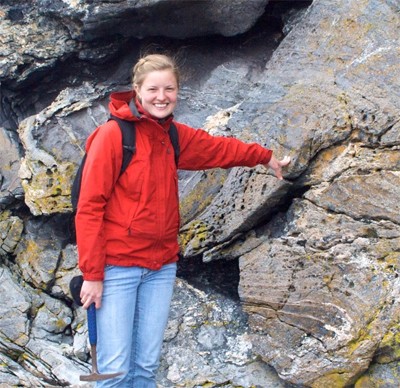Holly Steenkamp

2013 Jack Henderson Best M.Sc. Thesis Award
GAC Structural & Tectonics Subdivision
M.Sc. Thesis
A Metamorphic History of Supracrustal Rocks on Harøya and Finnøya, Nordøyane, Western Gneiss Region, Norway
(PDF - 136.5 Mb)
The tectonometamorphic histories of allochthonous nappe units that were deeply buried and subsequently exhumed during the Scandian orogeny in the Western Gneiss Region (WGR) of Norway are poorly constrained and understood. One such unit is the Blåhø Nappe which underlies northern Harøya and Finnøya, two islands in the Nordøyane ultrahigh-pressure (UHP) metamorphic domain. The Blåhø Nappe contains a lower unit of garnet amphibolite gneiss with interlayered garnet-bearing quartzofeldspathic gneiss and marble, and an upper unit of migmatitic aluminous gneiss. Southern Harøya comprises orthogneisses attributed to the Baltican continental crust, and is separated from the Blåhø Nappe by the Finnøya migmatitic shear zone (FMSZ). Field and petrographic observations from these islands suggest that the Blåhø Nappe experienced peak metamorphism at high pressure amphibolite to granulite facies conditions before being overprinted by relatively lower pressure amphibolite facies conditions. In contrast, the adjacent Baltican basement gneiss contains coesite-eclogite pods, which attests to UHP conditions. However, the basement rocks are also overprinted by an amphibolite facies assemblage. To understand the implications of these observations, the metamorphic history of the Blåhø Nappe was investigated, and compared to that of the basement. This thesis presents thermobarometric and geochronologic analyses used to define a metamorphic pressure-temperature-time (PTt) path for the Blåhø Nappe on Harøya and Finnøya. The results suggest prograde metamorphism between ca. 440 Ma and 415 Ma, peak temperature metamorphism at 860?C and 15 kbar at around 410 Ma, equilibration at amphibolite-facies conditions of 680?C and 9 kbar by 395 Ma, and cooling below Ar-closure T in muscovite by ca. 360 Ma. The PTt data from the Blåhø Nappe demonstrate that these rocks did not share the UHP history of the adjacent basement rocks, but that both experienced similar amphibolite facies metamorphism and deformation. These units were likely juxtaposed along the FMSZ during isothermal decompression from their respective maximum burial depths to ~30 km depth.
Keywords:
Pages: 207
Supervisor: Rebecca Jamieson



